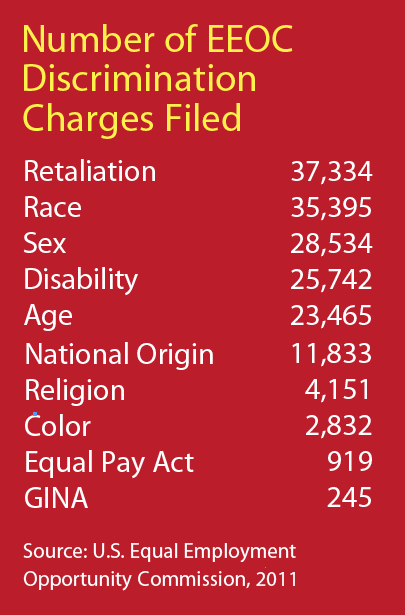New EEOC regulations have increased the legal challenges for employers at both ends of the employment process. How can employers avoid the pitfalls?
 You're Hired
You're Hired
Avoiding liability during pre-employment background checksby Mike Farnan and Jessica Milko
In December 2011, a CareerBuilder/Harris Interactive survey revealed that more than two-thirds of companies were affected by a bad hire in the past year. For 41% of those companies, the mistake cost them at least $25,000. Given this, it is no surprise that the expense of a bad hire is making employers increasingly conscious of how they make hiring decisions. In addition, the growth of negligent hiring claims, fraud, workplace violence, tort liability and the negative publicity that can accompany any of these have heightened the importance of making sure the candidate a company hires is the right one.
Many companies already conduct cursory background checks: they do an online criminal history search and make a quick call to employee-supplied references. But this is largely as an exercise in formality rather than a true effort to gain an understanding of the candidate’s background, activities and character. And this approach usually fails to compile a clear and detailed picture of a person.
Considering the expense and hassle associated with hiring, training and firing a bad employee, it is surprising that so many remain reticent to conduct more thorough pre-employment background checks. For some, cost could be a factor. For others, it could be that laws and policies issued by the federal government have caused employers to think twice before checking backgrounds. But if proper procedures are followed, this latter concern is entirely avoidable.
Updated EEOC Guidelines
New guidelines issued by the U.S. Equal Employment Opportunity Commission (EEOC) in April 2012 appear to up the ante on identifying perceived risks associated with background checks. These guidelines reiterate the EEOC’s long-standing policy that criminal history checks alone are not sufficient to determine suitability for hiring.
Specifically, the EEOC indicated that while arrest records are not probative that criminal conduct has occurred, convictions are. The agency has also stressed that criminal record exclusions have a “disparate impact” based on race, sex and national origin. And most importantly, it has noted that a policy of excluding all applicants with a criminal history—particularly when the issue is not “job-related or consistent with business necessity”—should be avoided (unless required, as it is in certain professions, by other federal laws).
But rather than causing employers to turn away from using any background check, these guidelines should empower employers to gain a clearer picture by conducting more in-depth investigations.
Disparate Impact
Title VII of the Civil Rights Act of 1964 prohibits discrimination on the basis of race, color, religion, sex or national origin. To treat members of certain racial, ethnic or gender groups differently than others who have a similar history—criminal or otherwise—is discriminatory and thus illegal. The more difficult issue is to discern cases where blanket criminal history checks may unjustifiably and disproportionately exclude from employment individuals of a particular race, sex or national origin. These cases are known as “disparate impact” discrimination cases.
The reason is that certain racial or ethnic groups tend to have more contact with law enforcement, often based on factors such as the communities where they live. To make hiring decisions based solely on contact with law enforcement would disproportionately impact members of that community. The EEOC understandably opposes “disparate impact” discrimination.
To avoid the problem of disparate impact, the EEOC guidelines encourage employers to conduct a more in-depth investigation to establish aggravating and mitigating factors surrounding any criminal history.
The guidelines also require employers to take a hard look at the job that they are trying to fill. Factors such as the details underlying a conviction, the recency of the conviction, the age of the applicant at the time of the conviction, the severity of the criminal conduct, any discernible pattern of criminal behavior, steps taken to address underlying causes, and numerous other circumstances should be considered rather than enacting a blanket prohibition against hiring those with criminal records. This information can be developed in a background check.
Using conclusions drawn from various social science and criminology research and studies, the EEOC guidelines have focused on assessing the use of criminal history records in employment decisions. Some of these efforts were spawned by judicial decisions. In El v. Southeastern Pennsylvania Transportation Authority (SEPTA), for example, plaintiff Douglas El was fired from his job as a bus driver for the mentally and physically disabled after his employer learned he had a 40-year-old conviction on his record for second-degree murder. El argued that SEPTA’s policy of terminating the employment of those with violent offenses was a violation of Title VII since it was discriminatory to minorities who were more likely to have criminal records.
Ultimately, however, the U.S. Court of Appeals for the Third Circuit found in favor of SEPTA and ruled that the company “adapted” the business necessity approach to criminal convictions by noting that such hiring policies “ultimately concern the management of risk” of future actions that “endanger the employer’s patrons.”
Although noting that it is never possible to measure risk perfectly, the court stated that the policy should “distinguish between applicants that pose an unacceptable level of risk and those that do not.” SEPTA experts argued that former violent criminals presented a greater risk for committing violent behavior in the future, and so the court determined that no reasonable juror could conclude that SEPTA’s hiring policy was inconsistent with a business necessity even though El’s conviction had happened so long ago.
Gather Sufficient Information
In effect, the EEOC is challenging human resource professionals to exercise judgment, rather than robotically apply a criminal history litmus test to job applicants. Sound judgment can only occur with sufficient information.
If a company can show that it considered all of the factors in its hiring decision and did not just set a blanket prohibition based on criminal history records, then it should have nothing to worry about. Those companies would not only hire the best employees available, but they would also be well positioned to defend a claim of disparate impact discrimination effectively.
The best practice is to reserve the use of a background check until a conditional offer of employment is made. Then, if a candidate has failed to disclose criminal history through the hiring process, the decision is easy because it is based on failing the test of honesty. Assuming everything is disclosed, the employer simply must consider whether a candidate’s criminal history is a deal breaker.
For example, a teaching applicant with a history of indecent assault against minors or a bus driver applicant with multiple, recent drunk driving convictions are not likely to be hired for those positions. In fact, hiring those applicants under those circumstances could expose the employer to a claim of negligent hiring if the unthinkable happens.
If a background check is undertaken, it should be thorough if an employer wants to effectively manage the risk of hiring a bad employee. A background check should not merely check criminal history but all references, former employers and others who might know information pertaining to the candidate’s suitability for a particular position.
Most people would never dream of making a substantial purchase sight-unseen, yet many companies do just that and wish, after the fact, that they had done more due diligence. Once a decision is made to bring someone on board, the real danger is not in knowing too much, but in knowing too little.
 You're Fired
You're Fired
Preventing discrimination charges and EPL lawsuits after an employee terminationby Catherine M. Padalino
Employment discrimination charges have hit an all-time high, as jilted workers who believe they have been unjustly terminated are increasingly looking to sue their former employers. According to the Equal Employment Opportunity Commission (EEOC), there were 99,947 discrimination charge filings in 2011—the highest number of filings in the agency’s reporting history. And every one of these charges of misconduct must be defended by the employer. From class action lawsuits to single-plaintiff employment practices liability (EPL) litigation, businesses of all sizes are increasingly vulnerable, and the financial implications can be crippling for those that are ill prepared.
In insurer Chubb’s 2010 “Private Company Survey,” 36% of executives responded that an EPL lawsuit would cause the most financial damage to their companies. Of those companies that experienced an EPL charge or lawsuit in the past five years, 46% reported costs to the company ranging between $20,000 and $750,000, with an average loss of more than $50,000.
This trend is expected to continue as high layoff rates and extensive legislative reform have helped create an environment where it is almost expected that employees may look for cause to bring an EPL claim against their employer.
 Economic and Regulatory Impact
Economic and Regulatory ImpactThe economic crisis and the nation’s subsequent lackluster recovery has had a significant impact on the increase in EPL lawsuits. As unemployment rates remain high and the time people are spending out of work increases, employees who have lost their jobs are more likely to file a lawsuit.
Laid-off workers with no new job on the horizon or those who have taken a job that pays less than their previous salary are looking to replace lost income. As a result, laid-off workers are seeking higher damages, and this raises the potential value of a lawsuit—an attractive feature for plaintiff attorneys.
Several new pieces of legislation have also enhanced opportunities for laid-off employees to sue their former employers. In November 2010, the EEOC issued final regulations regarding the Genetic Information Nondisclosure Act of 2008 (GINA), making it illegal to request and use genetic health information to discriminate against employees or applicants for employment. The legislation bars employers from using individuals’ genetic information to influence career-based decisions for a current or potential employee.
What Can Employers Do?
There are steps employers can take to help mitigate the risk, or at least help create a defense, if a former or current employee should bring an EPL lawsuit.
1. Stay abreast of the evolving legal landscape. In order to prevent gaps in your knowledge, remain up-to-date on legislation. Or consult with an attorney to help reduce the potential for losses.
2. In your risk management plan, include extensive policies to address workplace exposures relating to discrimination, harassment, hiring and termination.
3. Document appropriately. Evidence is a powerful tool during legal disputes. Documenting will enable you to, if necessary, offer proof of actions that were taken.
4. Train and educate your employees, managers and supervisors on policies and legal issues, making sure the front lines are aware of retaliation exposures.
5. Enforce policies fairly and consistently throughout your organization. This, more than anything else, will help reduce the potential for a suit.
While this is not an unreasonable piece of legislation in today’s world, where a significant amount of personal medical information can be easily accessed, it does add another avenue for legal action. Since the EEOC implemented the employment provisions of the act, several hundred GINA-related lawsuits have been pursued.
An Americans with Disabilities Act (ADA) change in 2009 has also sparked an increase in claims. The amendment broadened the interpretation of “disability” qualifiers, specifically what is meant by “major life activities”—now anything from walking to learning is included in the act. Since more employees are considered disabled under the expanded definition, employers’ exposure to such claims has increased and does not appear to be slowing down.
For the second consecutive year, the leading charge filed with the EEOC is retaliation: a trend that is expected to continue. Retaliatory discrimination claims are particularly challenging for employers. Recent laws, such as the American Recovery and Reinvestment Act of 2009 and Patient Protection and Affordable Care Act, both of which contain protections for whistleblowers, have opened the floodgates for retaliation claims.
The EEOC has determined that an employer can be brought up on retaliatory charges if any adverse action is taken against an employee who has a discrimination complaint. This all-encompassing language not only protects people with legitimate claims but may also give leverage to claimants with weak allegations.
Beyond the lagging economy, an ever-evolving legal landscape has played a role in the uptick of activity in EPL lawsuits. Employers can face serious financial repercussions when legal action is taken by an employee.
By observing best practices, employers can further help mitigate their risk with employment practices liability insurance. Employers can partner with their insurance agent and carrier to tap into EPL loss prevention tools and resources to assist them in navigating these often murky waters and staying out of the courtroom.
